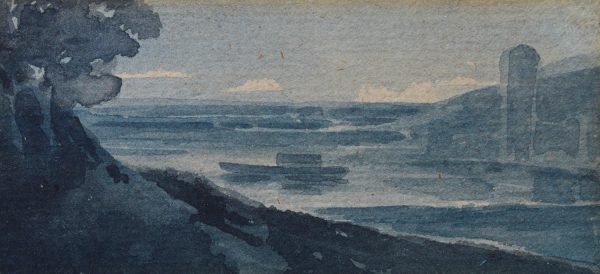Girtin, Thomas (1775-1802)
Thomas Girtin was born in Southwark, London, the son of a wealthy brushmaker of Huguenot descent. His father died while he was a child, and his mother then married a Mr Vaughan, a pattern-draughtsman. Girtin learnt drawing as a boy (attending classes with Thomas Malton), and was apprenticed to the topographical watercolourist Edward Dayes. Girtin is believed to have served out his seven-year term, although there are unconfirmed reports of clashes between master and apprentice, and even that Dayes had Girtin imprisoned as a refractory apprentice. Dayes did not appreciate his pupil’s talent, and he was to write dismissively of Girtin after his death.
While a teenager, Girtin became friends with the young J. M. W. Turner. The boys were employed to colour prints with watercolours. Girtin exhibited at the Royal Academy from 1794. His architectural and topographical sketches and drawings established his reputation, his use of watercolour for landscapes being such as to give him the credit of having created Romantic watercolour painting. He went on sketching tours, visiting the north of England, North Wales and the West Country. By 1799, he had acquired influential patrons such as Lady Sutherland and the art collector Sir George Beaumont. Girtin was the dominant member of the brothers, a sketching society of professional artists and talented amateurs.
In 1800, Girtin married Mary Ann Borrett, the 16-year-old daughter of a wealthy City goldsmith, and set up home in St George’s Row, Hyde Park, next door to the painter Paul Sandby. By 1801, by this time suffering from deteriorating health, he was a welcome houseguest at his patrons’ country houses such as Harewood House and Mulgrave Castle, and able to charge 20 guineas for a painting.
In late 1801 to early 1802, Girtin spent five and a half months in Paris, where he painted watercolours. He made a series of pencil sketches that he engraved on his return to London, and which were posthumously published as Twenty Views in Paris and its Environs. In 1802, Girtin produced a panorama of London, the “Eidometropolis”, 5.5 metres (18 ft) high and 33 metres (108 ft) in circumference, which was exhibited that year. It was noted for its naturalistic treatment of urban light and atmosphere. In November 1802, Girtin died in his painting room; the cause was variously reported as asthma, consumption, or “ossification of the heart.” He was buried in the churchyard of St Paul’s, Covent Garden in London.
Showing the single result
